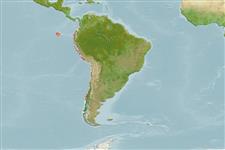>
Alepocephaliformes (Slickheads and tubeshoulders.) >
Alepocephalidae (Slickheads)
Etymology: Alepocephalus: Greek, alepos, alepidotos = without scales + Greek, kephale = head (Ref. 45335); planifrons: Named for its wide, smooth upper surface on the head.
Environment: milieu / Zona climática / intervalo de profundidade / distribution range
Ecologia
marinhas batidemersal; intervalo de profundidade 400 - 750 m (Ref. 41471). Deep-water
Southeast Pacific.
Tamanho / Peso / Idade
Maturidade: Lm ? range ? - ? cm
Max length : 31.7 cm SL (female)
Descrição suscinta
Chaves de identificação | Morfologia | Morfometria
Raios dorsais (total) : 17 - 20; Raios anais : 18 - 21; Vértebras: 52 - 54. Head relatively short, <39.5-0.025% SL. Snout short (22-28%HL); broadly triangular anteriorly when viewed from above. Orbit diameter about 1/5 to 1/4 HL, along the whole upper edge and on the separate elongate-shaped part of the lower-posterior part of the orbit are accumulation s of whitish connective tissue. Interorbital space very wide, ca. 17-30% HL, flat, narrows very slightly at the middle of the orbit. Upper jaw extends to below the center of the orbit. Branchiostegal rays 8-9. Transverse rows of scales above lateral line 60-65, 30-35 predorsal. Gill rakers' length less than gill lamellae length, and completely free at the base. Opercle has a projection at the lower anterior corner; subopercle has a wide posterior edge usually with no separate processes. Anus not shifted forward from the origin of the anal fin. Pyloric caeca 12-18 (Ref. 41471).
Body shape (shape guide): elongated; Cross section: compressed.
Inhabits continental slopes.
Ciclo de vida ou comportamento de acasalamento
Maturidade | Reprodução | Desova | Ovos | Fecundidade | Larvas
Sazonov, Y.I., 1994. A new species of slickhead Alepocephalus planifrons (Alepocephalidae) from the southeastern Pacific. J. Ichthyol. 34(2):104-111. (Ref. 41471)
Status na Lista Vermelha da UICN (Ref. 130435: Version 2025-1)
Ameaça para os humanos
Harmless
Uso pelos humanos
Ferramentas
Relatórios especiais
Baixar XML
Fontes da internet
Estimates based on models
Preferred temperature (Ref.
123201): 2.2 - 4, mean 2.6 °C (based on 75 cells).
Índice de diversidade filogenética (Ref.
82804): PD
50 = 0.5000 [Uniqueness, from 0.5 = low to 2.0 = high].
Bayesian length-weight: a=0.00347 (0.00163 - 0.00737), b=3.19 (3.00 - 3.38), in cm total length, based on LWR estimates for this (Sub)family-body shape (Ref.
93245).
Nível Trófico (Ref.
69278): 3.6 ±0.2 se; based on size and trophs of closest relatives
Resiliência (Ref.
120179): médio(a), tempo mínimo de duplicação da população 1,4 - 4,4 anos (Preliminary K or Fecundity.).
Fishing Vulnerability (Ref.
59153): Low to moderate vulnerability (29 of 100).
🛈
